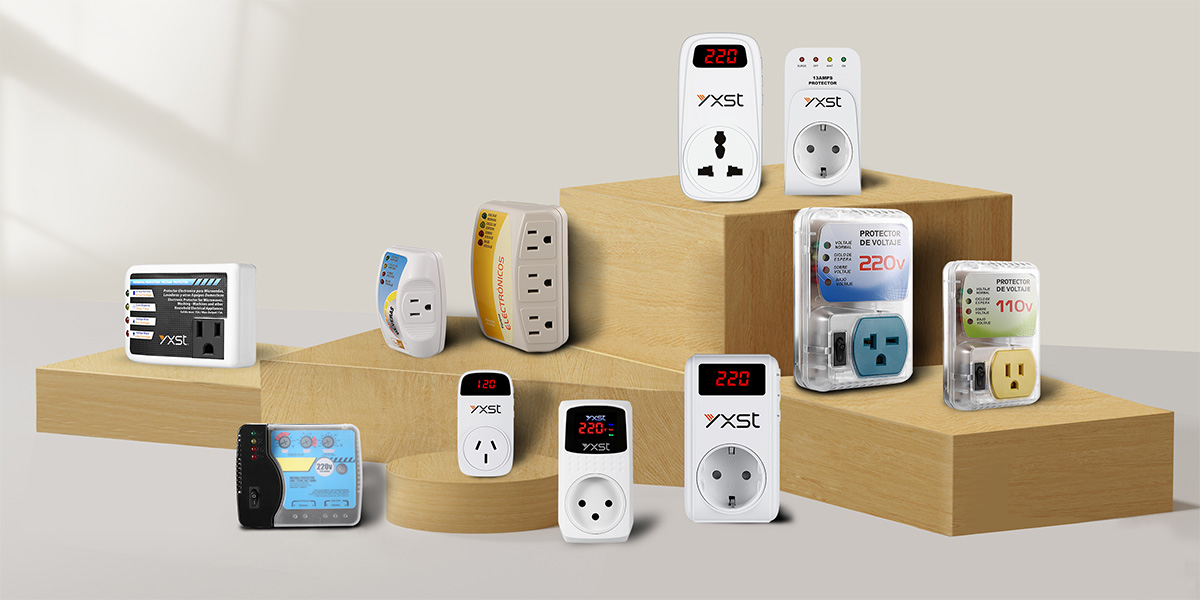The main differences between dual voltage surge protectors and single-phase voltage protectors are their design, application range, protection functions, and purpose.
Dual voltage surge protector:
Dual voltage surge protector is designed to handle and attenuate surge voltages in multi-phase systems, usually three-phase electrical systems.
It includes surge voltage attenuation units for each phase (R, S, T) and possibly the neutral (N) phase, providing comprehensive surge voltage protection for all phases.
Single-phase voltage protector:
It is designed for single-phase electrical systems.

Single-phase voltage protectors focus on protecting against surge voltage on a single phase, making them simpler and more cost-effective to use in single-phase applications.
Here is a detailed introduction to dual voltage surge protectors and single-phase voltage protectors:
Dual voltage surge protector Information
Voltage range:
Dual voltage surge protectors are capable of handling two different voltage levels, usually 110V and 220V, or similar common electrical standards.
This means that it is designed to protect equipment that may be used in areas with different voltage systems.
Application:
This type of surge protector is ideal for international use, where electrical systems can operate at either 110-120V (e.g. North America) or 220-240V (e.g. Europe, Asia). It ensures your devices are protected regardless of the voltage level provided.
Protection function:
It specifically protects devices from voltage surges (spikes) or electrical faults on 110V and 220V circuits. It helps prevent high voltage damage that occurs due to power outages, lightning strikes, or grid problems.
Common uses:
For electronic equipment, appliances, or machinery used in different countries with different electrical standards. It is also useful for people traveling abroad with electrical equipment.
Single-phase voltage protector Information
Voltage range:
Single-phase voltage protectors are designed for single-phase electrical systems, typically used in residential or small businesses. It is designed to protect devices connected to single-phase circuits (110V or 220V systems, but not both).
Application:
This type of protector is designed for areas or applications where only one voltage level is used. For example, in North America it might protect devices running on a 110V circuit; in much of Europe, it will protect devices on a 220V circuit.
Protection:
It protects against voltage fluctuations such as overvoltage (high voltage), undervoltage (low voltage), and voltage spikes. The protector ensures that the device is not damaged by irregular voltage levels that may occur during an electrical fault or surge.
Common Uses:
Common in residences or small businesses that have only one voltage system (single phase). This includes typical household appliances such as refrigerators, air conditioners, televisions, and computers.
Key Differences Between Dual Voltage Surge Protectors and Single Phase Surge Protectors:
Voltage Range:
Dual Voltage Surge Protectors: Can protect devices running on both 110V and 220V systems.
Single Phase Surge Protectors: Protect devices on a single voltage system (110V or 220V).
Applications:
Dual Voltage Surge Protectors: For devices that are used internationally or run on multiple voltage systems.
Single-phase surge protector: For use on single-phase electrical systems, typically in residential or small commercial settings.
Types of protection:
Dual voltage surge protector: Focuses on protecting against surges and spikes on two voltage systems.
Single-phase surge protector: Protects against overvoltage, undervoltage, and voltage fluctuations on single-phase systems.
Dual voltage surge protector VS Single phase voltage protector Summary:
Dual voltage surge protectors are ideal for use in areas with 110V and 220V systems, or for equipment that may be used internationally and have different voltage levels.
Single-phase surge protectors are designed to protect equipment that operates on either 110V or 220V systems, but not both. It is most commonly used in areas with single-phase electrical systems.
In summary, the key difference is that dual voltage surge protectors are designed for multi-phase systems, while single-phase surge protectors are designed for single-phase systems.




